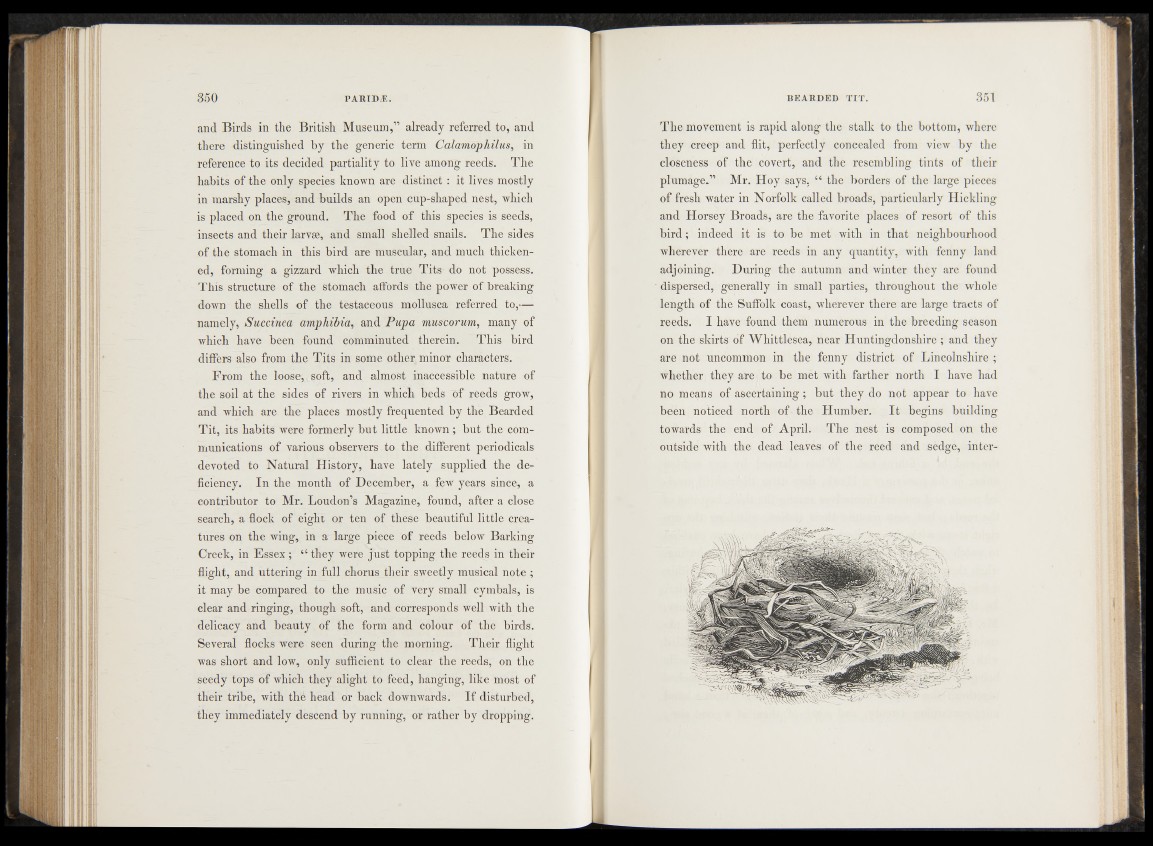
and Birds in the British Museum,” already referred to, and
there distinguished by the generic term Calamophilus, in
reference to its decided partiality to live among reeds. The
habits of the only species known are distinct: it lives mostly
in marshy places, and builds an open cup-shaped nest, which
is placed on the ground. The food of this species is seeds,
insects and their larvae, and small shelled snails. The sides
of the stomach in this bird are muscular, and much thickened,
forming a gizzard which the true Tits do not possess.
This structure of the stomach affords the power of breaking
down the shells of the testaceous mollusca referred to,—
namely, Succinea amphibia, and Pupa muscorum, many of
which have been found comminuted therein. This bird
differs also from the Tits in some other minor characters.
From the loose, soft, and almost inaccessible nature of
the soil at the sides of rivers in which beds of reeds grow,
and which are the places mostly frequented by the Bearded
Tit, its habits were formerly but little known ; but the communications
of various observers to the different periodicals
devoted to Natural History, have lately supplied the deficiency.
In the month of December, a few years since, a
contributor to Mr. Loudon’s Magazine, found, after a close
search, a flock of eight or ten of these beautiful little creatures
on the wing, in a large piece of reeds below Barking
Creek, in Essex ; “ they were just topping the reeds in their
flight, and uttering in full chorus their sweetly musical note ;
it may be compared to the music of very small cymbals, is
clear and ringing, though soft, and corresponds well with the
delicacy and beauty of the form and colour of the birds.
Several flocks were seen during the morning. Their flight
was short and low, only sufficient to clear the reeds, on the
seedy tops of which they alight to feed, hanging, like most of
their tribe, with thé head or back downwards. If disturbed,
they immediately descend by running, or rather by dropping.
The movement is rapid along the stalk to the bottom, where
they creep and flit, perfectly concealed from view by the
closeness of the covert, and the resembling tints of their
plumage.” Mr. Hoy says, | ‘ the borders of the large pieces
of fresh water in Norfolk called broads, particularly Hickling
and Horsey Broads, are the favorite places of resort of this
bird; indeed it is to be met with in that neighbourhood
wherever there are reeds in any quantity, with fenny land
adjoining. During the autumn and winter they are found
dispersed, generally in small parties, throughout the whole
length of the Suffolk coast, wherever there are large tracts of
reeds. I have found them numerous in the breeding season
on the skirts of Whittlesea, near Huntingdonshire ; and they
are not uncommon in the fenny district of Lincolnshire ;
whether they are to be met with farther north I have had
no means of ascertaining; but they do not appear to have
been noticed north of the Humber. I t begins building
towards the end of April. The nest is composed on the
outside with the dead leaves of the reed and sedge, inter